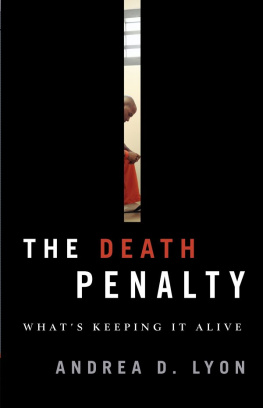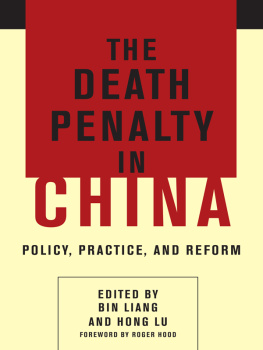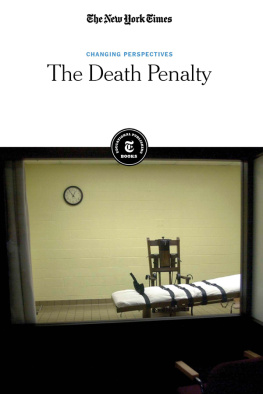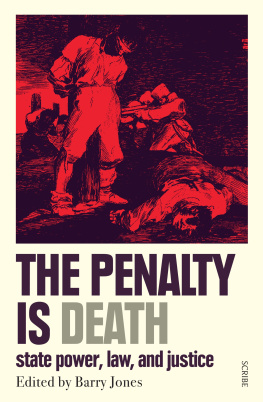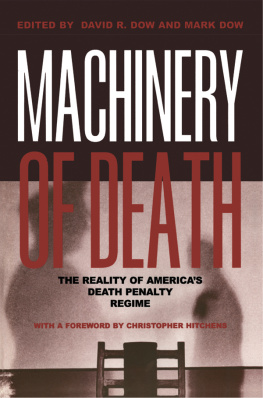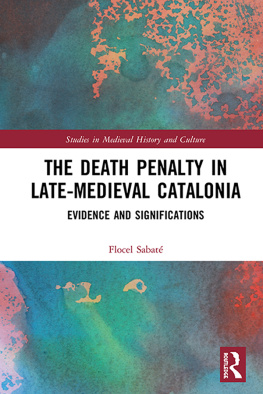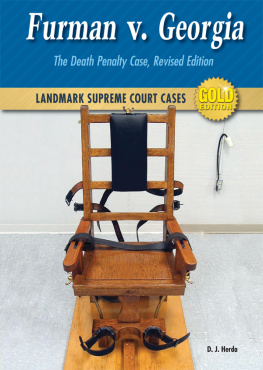Lyon - The death penalty: whats keeping it alive
Here you can read online Lyon - The death penalty: whats keeping it alive full text of the book (entire story) in english for free. Download pdf and epub, get meaning, cover and reviews about this ebook. City: Lanham;etc, year: 2015;2012, publisher: undefined;Rowan & Littlefield, genre: Politics. Description of the work, (preface) as well as reviews are available. Best literature library LitArk.com created for fans of good reading and offers a wide selection of genres:
Romance novel
Science fiction
Adventure
Detective
Science
History
Home and family
Prose
Art
Politics
Computer
Non-fiction
Religion
Business
Children
Humor
Choose a favorite category and find really read worthwhile books. Enjoy immersion in the world of imagination, feel the emotions of the characters or learn something new for yourself, make an fascinating discovery.
The death penalty: whats keeping it alive: summary, description and annotation
We offer to read an annotation, description, summary or preface (depends on what the author of the book "The death penalty: whats keeping it alive" wrote himself). If you haven't found the necessary information about the book — write in the comments, we will try to find it.
The death penalty: whats keeping it alive — read online for free the complete book (whole text) full work
Below is the text of the book, divided by pages. System saving the place of the last page read, allows you to conveniently read the book "The death penalty: whats keeping it alive" online for free, without having to search again every time where you left off. Put a bookmark, and you can go to the page where you finished reading at any time.
Font size:
Interval:
Bookmark:
The Death Penalty
Whats Keeping It Alive
Andrea D. Lyon
ROWMAN & LITTLEFIELD
Lanham Boulder New York London
Published by Rowman & Littlefield
A wholly owned subsidiary of
The Rowman & Littlefield Publishing Group, Inc.
4501 Forbes Boulevard, Suite 200, Lanham, Maryland 20706
www.rowman.com
Unit A, Whitacre Mews, 26-34 Stannery Street, London SE11 4AB,
United Kingdom
Copyright 2015 Rowman & Littlefield
All rights reserved. No part of this book may be reproduced in any form or by any electronic or mechanical means, including information storage and retrieval systems, without written permission from the publisher, except by a reviewer who may quote passages in a review.
British Library Cataloguing in Publication Information Available
Library of Congress Cataloging-in-Publication Data
Lyon, Andrea D.
The death penalty : whats keeping it alive / Andrea D. Lyon.
pages cm
Includes bibliographical references and index.
ISBN 978-1-4422-3267-9 (cloth : alk. paper) ISBN 978-1-4422-3268-6 (electronic)
1. Capital punishmentUnited StatesHistory. I. Title.
HV8699.U5L96 2015
364.660973dc23
2014025513
 TM The paper used in this publication meets the minimum requirements of American National Standard for Information Sciences Permanence of Paper for Printed Library Materials, ANSI/NISO Z39.48-1992.
TM The paper used in this publication meets the minimum requirements of American National Standard for Information Sciences Permanence of Paper for Printed Library Materials, ANSI/NISO Z39.48-1992.
Printed in the United States of America
For my father
While most people have seen trials on television, fictional or otherwise, most have not been in courtrooms themselves. In a criminal trial, there is usually an obvious divide between the courtroom observerswhat I jokingly call the brides side and the grooms side. The brides side is the defense (in my mind at least), and the grooms side is the prosecution. That is, the prosecution team sits on the side of the courtroom closest to the jury and their supporters do, too. The defense sits at the other table and the defendants family or supporters sit on that side.
Nowhere is this divide more apparent than in a death penalty trial. Emotions run high, and at the point a jury is considering whether to execute the defendant, they can rise to a fever pitch.
When I was a member of the Chicago Public Defenders Homicide Task Force, there were times when we represented people whom no one cared to support in any way. They were often charged with awful crimes, facing the death penalty, and their families had long since given up on them. One such case was that of a man named Edgar Hope. Hope was charged with the killing of an Irish police officer on a bus. There had been a disturbance on the bus and the driver had called the police. The officer came on the bus, located Hope and searched him, but missed the gun Hope had on him. A struggle ensued and Hope shot the officer in front of many passengers.
The only issue in the case was the punishment. There was no question of guilt. There was no question that he was eligible to be sentenced to death under the Illinois statute for the killing of a police officer in the line of duty. The only question was whether the jury would sentence him to death or to life in prison.
This particular defendant didnt have any family, and so some of usthat is, other public defenderswould come to court and sit on that side of the courtroom in support of our beleaguered colleagues.
The trial resulted in conviction, a foregone conclusion. The jury took no time to find him eligible for death (not every murder can be a death casethe prosecution has to show first-degree murder plus an aggravating or eligibility factor). The word went out in the criminal courts building that there was a verdict on the death penalty hearing. We all knew what it would be. An Irish judge had presided over an all-white jury that had been exhorted by two white prosecutors. It was an election year. There was a dead police officer.
I went to the courtroom to lend support to my public defender colleagues. I looked across the aisle to the prosecutions side. There were rows of prosecutors there; perhaps thirty or so. All of them were lawyers. They had all gone to college, as I had, and done reasonably well. They had all gone to law school, as I had, and done reasonably well there, too. They had all passed the Illinois bar exam, too, as had I, and had sworn to uphold the laws of the United States and Illinois, as I had. More than that, as prosecutors, they promised to represent the people of the state of Illinois, which included me, the defendant on trial, and everyone else in that courtroom.
When the defendant was brought out from the lock-up, everyone stood as the verdictin this case what the sentence was to bewas read. It was death.
When it was read, those prosecutors stood and cheered. And they yelled, Kill him! Kill him! Kill him!
That is when I realized, beyond any doubt, that the death penalty was both more and less than the ultimate punishment for murder.
This book draws on my years as a death penalty defender as well as extensive research on the subject to analyze why the death penalty remains such a fixture of the justice system, in spite of its many documented flaws, such as wrongful convictions, racial and socioeconomic
We spend more to execute than to incarcerate, there is no evidence that the death penalty deters violent crime, we convict and sentence the innocent, and, as can be seen, we brutalize all of us in the process.
This book explores the nature of the death penalty as a political statement and tool in order to try to answer the question posed by the books title: whats keeping the death penalty alive?
http://deathpenaltyinfo.org/node/5760.
During that period, 8,776 people were executed and 276 of those executions went wrong in some way. Of all the methods used, lethal injection had the highest rate of botched executionsabout 7 percent.
I want to thank my steadfast editors, Joan Liebsen-Smith, Mary Bandstra, and Melissa Hernandez. I also want to thank University of Iowa law students Zane Ulmstead and Ryan Beckenbaugh, and DePaul University College of Law students Melissa Hernandez and Alana de Leon for their assistance in both research and writing.
I also want to thank the many teachers I have had, both in school and out, who taught me to look beneath the surface, to solve problems vertically, and to care about the world and its inhabitants.
On January 17, 1977, Gary Gilmore was executed by a firing squad in the state of Utah. The night before, his relatives visited with him for the last time. His uncle snuck in some whiskey for Gilmore to drink. Gilmores attorney notified Johnny Cash that he was Gilmores favorite singer, and Cash called the prison to sing him a song. Gilmore sang along.
The next morning, at 8:00 a.m., the firing squad assembled. Five volunteers placed the barrels of their rifles through holes in a wall. Each rifle aimed at Gilmorestrapped to a chair with a paper target placed over his heart and a black hood placed over his head. A wall of sandbags stood behind Gilmore to catch the bullets that aimed in his direction. At 8:07 a.m. the squad members pulled their respective triggers, and Gary Gilmore was executed. His last words were, Lets do it.
In October 1976, Gilmore had been convicted for the murder of a motel manager in Provo, Utah, and sentenced to death. Although defendants sentenced to the death penalty generally choose to challenge their sentences, favoring the alternative of life imprisonment to the prospect of execution, Gilmore accepted his death sentence without protest. Nevertheless, many antideath penalty groups acted in what they saw as Gilmores best interest and fought against his execution. The American Civil Liberties Union (ACLU) and the National Association for the Advancement of Colored People (NAACP) got involved. Even Gilmores mother and brother sought to stay his execution, until Gilmore finally convinced them of his wishes to see his sentence through.
Font size:
Interval:
Bookmark:
Similar books «The death penalty: whats keeping it alive»
Look at similar books to The death penalty: whats keeping it alive. We have selected literature similar in name and meaning in the hope of providing readers with more options to find new, interesting, not yet read works.
Discussion, reviews of the book The death penalty: whats keeping it alive and just readers' own opinions. Leave your comments, write what you think about the work, its meaning or the main characters. Specify what exactly you liked and what you didn't like, and why you think so.

